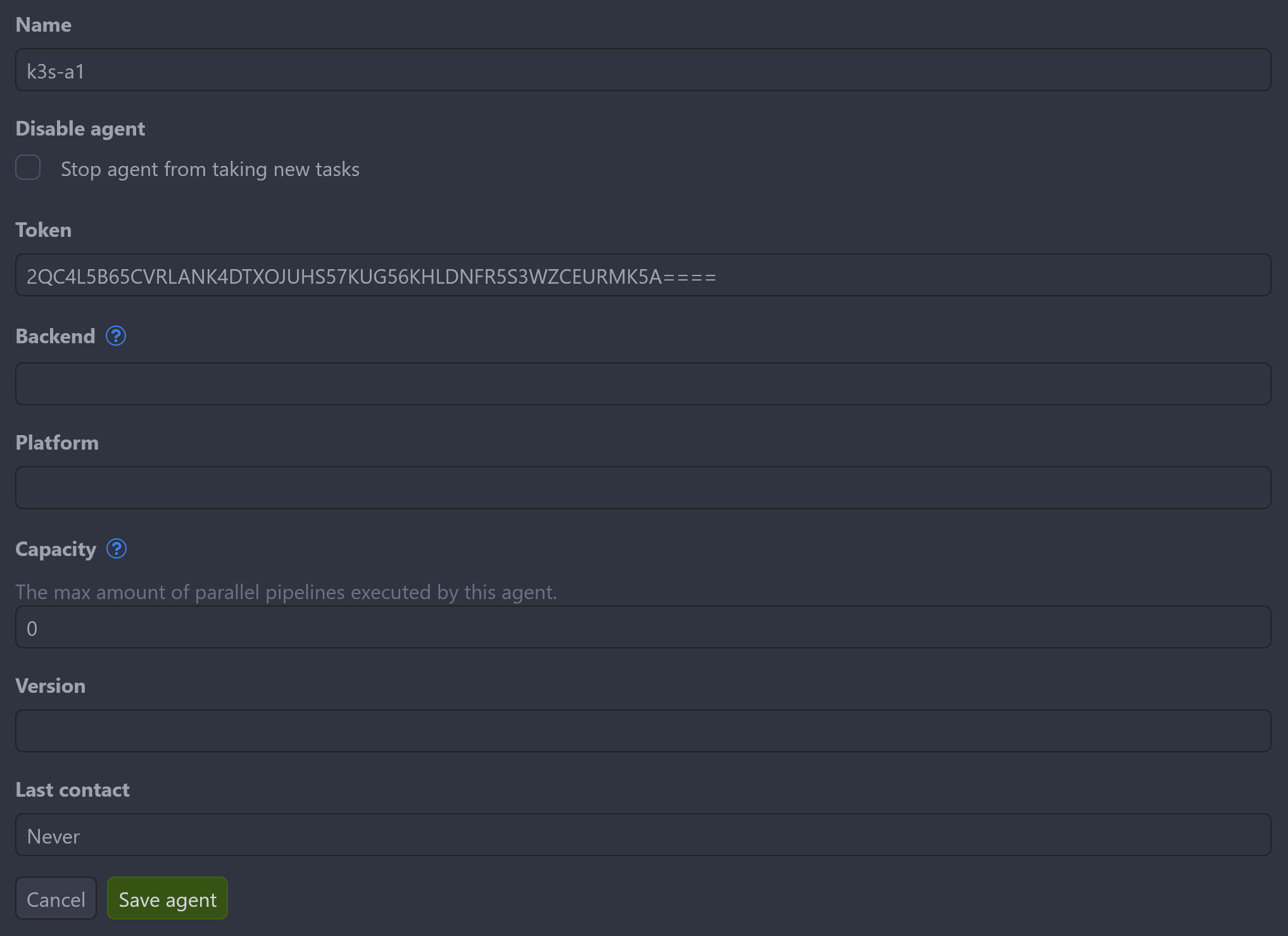Agent configuration
Agents are configured by the command line or environment variables. At the minimum you need the following information:
WOODPECKER_SERVER=localhost:9000
WOODPECKER_AGENT_SECRET="your-shared-secret-goes-here"
The following are automatically set and can be overridden:
WOODPECKER_HOSTNAMEif not set, becomes the OS' hostnameWOODPECKER_MAX_WORKFLOWSif not set, defaults to 1
Workflows per agent
By default, the maximum workflows that are executed in parallel on an agent is 1. If required, you can add WOODPECKER_MAX_WORKFLOWS to increase your parallel processing for an agent.
WOODPECKER_SERVER=localhost:9000
WOODPECKER_AGENT_SECRET="your-shared-secret-goes-here"
WOODPECKER_MAX_WORKFLOWS=4
Agent registration
When the agent starts it connects to the server using the token from WOODPECKER_AGENT_SECRET. The server identifies the agent and registers the agent in its database if it wasn't connected before.
There are two types of tokens to connect an agent to the server:
Using system token
A system token is a token that is used system-wide, e.g. when you set the same token in WOODPECKER_AGENT_SECRET on both the server and the agents.
In that case registration process would be as following:
- The first time the agent communicates with the server, it is using the system token
- The server registers the agent in its database if not done before and generates a unique ID which is then sent back to the agent
- The agent stores the received ID in a file (configured by
WOODPECKER_AGENT_CONFIG_FILE) - At the following startups, the agent uses the system token and its received ID to identify itself to the server
Using agent token
An agent token is a token that is used by only one particular agent. This unique token is applied to the agent by WOODPECKER_AGENT_SECRET.
To get an agent token you have to register the agent manually in the server using the UI:
- The administrator registers a new agent manually at
Settings -> Agents -> Add agent
- The generated token from the previous step has to be provided to the agent using
WOODPECKER_AGENT_SECRET - The agent will connect to the server using the provided token and will update its status in the UI:
All agent configuration options
Here is the full list of configuration options and their default variables.
WOODPECKER_SERVER
Default:
localhost:9000
Configures gRPC address of the server.
WOODPECKER_USERNAME
Default:
x-oauth-basic
The gRPC username.
WOODPECKER_AGENT_SECRET
Default: empty
A shared secret used by server and agents to authenticate communication. A secret can be generated by openssl rand -hex 32.
WOODPECKER_AGENT_SECRET_FILE
Default: empty
Read the value for WOODPECKER_AGENT_SECRET from the specified filepath, e.g. /etc/woodpecker/agent-secret.conf
WOODPECKER_LOG_LEVEL
Default: empty
Configures the logging level. Possible values are trace, debug, info, warn, error, fatal, panic, disabled and empty.
WOODPECKER_DEBUG_PRETTY
Default:
false
Enable pretty-printed debug output.
WOODPECKER_DEBUG_NOCOLOR
Default:
true
Disable colored debug output.
WOODPECKER_HOSTNAME
Default: empty
Configures the agent hostname.
WOODPECKER_AGENT_CONFIG_FILE
Default:
/etc/woodpecker/agent.conf
Configures the path of the agent config file.
WOODPECKER_MAX_WORKFLOWS
Default:
1
Configures the number of parallel workflows.
WOODPECKER_FILTER_LABELS
Default: empty
Configures labels to filter pipeline pick up. Use a list of key-value pairs like key=value,second-key=*. * can be used as a wildcard. By default, agents provide three additional labels platform=os/arch, hostname=my-agent and repo=* which can be overwritten if needed. To learn how labels work, check out the pipeline syntax page.
WOODPECKER_HEALTHCHECK
Default:
true
Enable healthcheck endpoint.
WOODPECKER_HEALTHCHECK_ADDR
Default:
:3000
Configures healthcheck endpoint address.
WOODPECKER_KEEPALIVE_TIME
Default: empty
After a duration of this time of no activity, the agent pings the server to check if the transport is still alive.
WOODPECKER_KEEPALIVE_TIMEOUT
Default:
20s
After pinging for a keepalive check, the agent waits for a duration of this time before closing the connection if no activity.
WOODPECKER_GRPC_SECURE
Default:
false
Configures if the connection to WOODPECKER_SERVER should be made using a secure transport.
WOODPECKER_GRPC_VERIFY
Default:
true
Configures if the gRPC server certificate should be verified, only valid when WOODPECKER_GRPC_SECURE is true.
WOODPECKER_BACKEND
Default:
auto-detect
Configures the backend engine to run pipelines on. Possible values are auto-detect, docker, local or kubernetes.
WOODPECKER_BACKEND_DOCKER_*
See Docker backend configuration
WOODPECKER_BACKEND_K8S_*
See Kubernetes backend configuration
WOODPECKER_BACKEND_LOCAL_*
See Local backend configuration
Advanced Settings
Only change these If you know what you do.
WOODPECKER_CONNECT_RETRY_COUNT
Default:
5
Configures number of times agent retries to connect to the server.
WOODPECKER_CONNECT_RETRY_DELAY
Default:
2s
Configures delay between agent connection retries to the server.